Joint press release of DESY and European XFEL
A crucial component of the European XFEL has taken up operation: The so-called injector, the 45-metre long first part of the superconducting particle accelerator, has accelerated its first electrons to nearly the speed of light. This is the first beam ever accelerated at the European XFEL and represents a major advancement toward the completion of the facility.
The X-ray laser European XFEL is an international research facility in northern Germany that will produce ultrabright X-ray laser flashes for unprecedented studies of the nanocosmos. It consists of a 2-kilometre long superconducting linear electron accelerator, followed by a series of highly precise magnets to produce the highly brilliant X-ray laser light.
The injector, which is located on the DESY campus in Hamburg and has been under construction since 2013, produced a series of tightly packed sets of electrons, or bunches, that passed through the 45-metre long injector beamline. The electrons made the full trip from start to end of the injector in 0.15 microseconds, achieving near light speed.
The injector shapes the highly charged electron bunches and gives them their initial energy, which is gradually increased across a 2-kilometre long linear accelerator that is still being assembled. Once energized, the electrons will be ready to generate the facility’s X-ray flashes, enabling scientists to perform studies that are expected to have large impacts on medicine, energy production and storage, materials research, and many other fields.
DESY, which is European XFEL’s main shareholder and close partner, is responsible for the construction and operation of the electron injector as well as the rest of the linear accelerator. Components for the injector were produced across Europe by the 17-institute European XFEL Accelerator Consortium, which is led by DESY. This includes work done by DESY as well as in-kind contributions from institutes in France, Italy, Poland, Russia, Spain, Sweden, and Switzerland.
“All members of the European XFEL Accelerator Consortium contributed to the injector, and we appreciate their professionalism during design, construction, and installation,” says DESY leading scientist Dr. Hans Weise, who is coordinator for the Accelerator Consortium. “Their contributions now allow us to prepare the high-quality electron beam required for operation of the free-electron laser.”
The design of the injector is strongly based on the one found in DESY’s X-ray free-electron laser FLASH, the prototype facility for the European XFEL that began operation as a user facility in 2005. Several billion electrons are released from an electrode of caesium telluride when it is struck by an intense ultraviolet laser flash. The electrons form a bunch which is accelerated by radio frequency and kept together by intense magnetic fields. The bunch is accelerated, first through a normal conducting cavity made of copper, then through a pair of superconducting accelerator cryomodules. The two latter devices are chilled to -271°C by liquid helium to allow for highly efficient beam acceleration. These modules give the full electron beam the required characteristics needed for producing the X-ray flashes that will be used for researching matter at the atomic scale.
The injector will continue to go through rigorous testing while the rest of the linear accelerator is installed. The next major milestone will be accelerating electrons the for the full accelerator length to the European XFEL’s Osdorfer Born site approximately 2.1 km away from the start of the injector. This is expected in late 2016, with user operation to follow in 2017.
“The first electrons in the injector mark a major milestone for this ambitious discovery machine – my congratulations go to the physicists and engineers who have constructed and installed the components with great dedication,” says Prof. Helmut Dosch, chairman of the DESY Board of Directors. “And with more than half of the superconducting modules of the main accelerator tested and installed, I am sure that the start of the commissioning of the European XFEL accelerator will follow soon.”
“I am glad to see the efforts with constructing the injector come to a successful completion, as we continue our focus on finishing the rest of the accelerator so we can provide researchers with the world’s brightest X-ray light,” says Prof. Massimo Altarelli, managing director of European XFEL. “I want to thank everyone involved in the construction and start-up of this starting point for our facility.”


